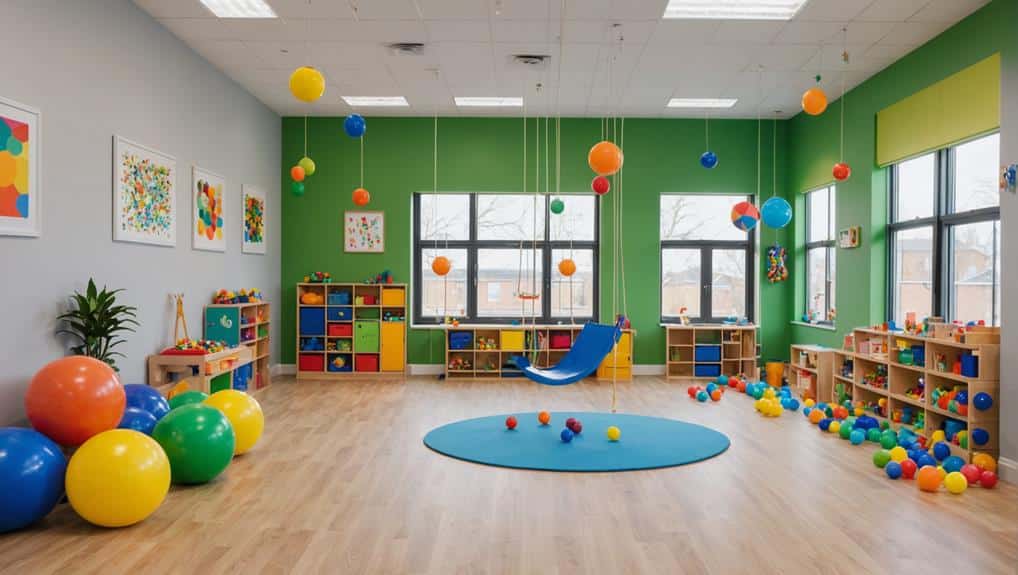Autism brings unique challenges that often require strategies to help each child reach their full potential. Using proven autism techniques, like early intervention and personalized treatment plans, can make a big difference. These methods focus on understanding each child’s needs and involving the family to support learning and growth.
But how do these proven autism techniques work? And what principles guide them? Parents and caregivers can work with professionals to create a supportive environment encouraging social, emotional, and cognitive development. By learning these strategies, you can open new doors for your child’s progress and help them thrive daily.
Key Takeaways
- Tailored therapies like ABA, DIR/Floortime, and CBT are effective techniques for empowering children with autism.
- Early intervention and personalized treatment plans enhance development and lessen autism symptoms in children.
- Active family involvement in autism treatment fosters a supportive environment and strengthens intervention progress.
- Alternative therapies such as music, art, and animal-assisted therapy complement traditional treatments for autism.
- Sensory integration therapy and stimulating sensory activities help to regulate sensory overwhelm and improve daily participation.
Understanding Autism Therapy
In Autism Spectrum Disorder (ASD), tailored therapies significantly address each child’s needs, strengths, weaknesses, and challenges. These therapies, including Applied Behavior Analysis (ABA), DIR/floortime, and Cognitive Behavioral Therapy (CBT), are designed to resonate with the distinct sensory characteristics of children with autism.
Notably, one of the challenges they often face is difficulty with eye contact. This could be due to a variety of reasons like distraction or social anxiety. Some therapy sessions, such as theater therapy, may focus on improving these eye contact skills.
A successful intervention strategy involves behavior, occupational, and speech-language therapy and requires the family’s active participation. This collaborative approach ensures a supportive environment that promotes the child’s growth and development.
The ultimate goal of autism therapy is to enrich the quality of life of these children. Each therapy plan is carefully crafted to align with the child’s requirements. This dynamic intervention strategy is framed by understanding the child’s abilities and potential. It is about enabling the child to navigate their world, to communicate effectively, and to achieve their fullest potential.
Autism therapy is not a one-size-fits-all solution but a personalized, all-encompassing approach that aims to nurture the child’s innate strengths while addressing their challenges.
Significance of Early Intervention
Recognizing the potential indicators of autism in the initial stages propels the opportunity for essential intervention. The importance of early intervention in the context of autism spectrum disorder cannot be underestimated. It is a critical point in the child’s developmental path, providing a foundation for improved long-term results. This is why consulting with developmental specialists at an early stage is highly recommended.
- Early Intervention and Development: Research indicates that the initial three years of a child’s life are crucial in their growth. Early intervention during this period can significantly improve the child’s progress and lessen the impact of autism symptoms. This approach also offers timely access to suitable therapies to enhance the child’s learning and development.
- Tailored Strategies: Early intervention allows for the creation of customized strategies that cater to each child’s needs. These personalized approaches pave the way for enhanced development and well-being. Additionally, they provide an opportunity to implement targeted therapies such as Applied Behavior Analysis (ABA).
- Treatment Success: Initiating treatment as soon as developmental delays are suspected significantly boosts the likelihood of treatment success. Timely intervention propels a child’s progress and reduces autism symptoms over time. It’s important to note that early intervention programs are a proactive step that can make a notable difference in a child’s life.
In essence, early intervention is a potent tool in managing autism spectrum disorder. By recognizing the signs early and implementing customized strategies, we can markedly increase the chances of treatment success, enabling children to achieve their full potential.
Crafting Personalized Treatment Plans

Crafting customized care plans for children with autism is a dynamic and collaborative endeavor involving specialized therapy approaches like ABA, DIR/Floortime, and CBT. Recognizing that each autistic person has their way of doing things is essential in developing these plans, enabling them to meet each child’s distinct requirements and abilities. The participation of family members not only fosters a nurturing atmosphere for the child but also enhances the effectiveness of the care plan. This involvement validates their emotions and underscores sincere affection and comprehension, an integral aspect of maneuvering through the autistic community.
Tailoring Therapy Techniques
The cornerstone of success in treating children with autism is the development of customized therapy plans that cater to their distinct requirements and strengths. These personalized plans are not one-size-fits-all but a framework for leveraging the child’s strengths and addressing their weaknesses to improve developmental outcomes. Part of this process includes understanding and respecting the child’s sensory needs and limits, just like during festive gatherings, to create a supportive environment for their development.
These tailored treatments typically consist of three key components:
- A holistic approach that involves behavioral, occupational, and speech-language therapy. This ensures a comprehensive treatment plan that targets all child development areas.
- Advocacy efforts, where therapists, educators, and families champion the child’s needs and rights, are essential in equipping them.
- Family involvement and a supportive environment are vital in implementing the personalized treatment plan. This involves educating family members about the child’s needs, including sensory supports, and maintaining routines to provide a stable environment.
This approach of personalized therapy plans, such as ABA, DIR/Floortime, and CBT, forms the basis of customized treatment plans. By addressing the child’s distinct requirements, utilizing their strengths, and involving the family, we can lay the groundwork for their growth and development, ultimately enabling them to lead fulfilling lives.
Importance of Family Involvement
Integral to the success of personalized treatment plans for children with autism is the active engagement of family members. This participation strengthens the intervention’s progress and profoundly influences the outcomes. A supportive environment, nurtured by family involvement, provides a caring space where children with autism can flourish and cultivate necessary skills.
Therapists’ and families’ collaborative efforts are vital in creating tailored treatment plans. As highlighted in effective advocacy strategies, these plans are not universal but customized interventions crafted with the child’s needs in mind. This approach aligns with the broader objective of promoting respect and appreciation for neurodiversity. The family’s deep understanding of the child’s strengths, weaknesses, and preferences is invaluable.
Apart from therapy sessions, family involvement extends to advocacy initiatives. Families become advocates for their children, maneuvering through the intricacies of educational, medical, and social systems. This advocacy, coupled with therapies like ABA, DIR/Floortime, and CBT, enables children with autism to foster their growth and progress.
Importance of Family Involvement
Bearing witness to the immense value of family participation, it is clear that its role in autism treatment significantly influences the progress and results of the intervention. It establishes the foundation for a cooperative approach between therapists and family members, nurturing an atmosphere conducive to the child’s development.
Family participation in autism treatment can:
- Strengthen skills acquired during therapy sessions, maintaining uniformity across all environments – home, school, and social gatherings.
- Create a supportive atmosphere that enriches the effectiveness of interventions, offering the child a safe, welcoming space to navigate and comprehend their experiences.
- Please contribute to creating therapy plans, ensuring they are customized to the child’s needs and circumstances.
This collaborative approach guarantees a more comprehensive intervention and provides families with the skills and knowledge to support their child’s progression. It fosters comprehension, acceptance, and empathy—elements vital for establishing a nurturing environment for children with autism. Thus, family participation is not just advantageous but essential to autism treatment.
Role of Therapy Professionals

Frequently, therapy experts, such as psychologists, speech therapists, and occupational therapists, are at the core of autism diagnosis and treatment. These professionals adopt a collaborative approach, working closely with families to establish a supportive environment for the child’s growth and development.
Tailored treatment plans are an essential component of this process. Therapy experts utilize their specialized knowledge to design these plans, personalized to each child’s strengths and weaknesses. The treatment plans could encompass a variety of interventions, from enhancing communication skills to implementing behavioral modification techniques, always to enable the child to reach their full potential.
A crucial part of this personalized treatment is individualized education. Special education teachers work diligently to implement strategies that complement the treatment plans created by therapy experts. They aim to empower children with autism to receive the best possible education, aligning their teaching methods with the child’s distinct learning style.
Exploring Alternative Therapies
Beyond traditional therapeutic interventions, an intriguing exploration into alternative therapies presents a promising approach to complementing autism treatments. These therapies, like music, art, and animal-assisted therapy, enhance communication, social skills, emotional well-being, and sensory processing in autistic children.
- Music Therapy: This creative form of therapy can enhance sensory processing and regulation capabilities in individuals with autism. It can assist in self-expression and cultivate an emotional bond with others, offering a channel for communication beyond words.
- Art Therapy: This therapeutic approach nurtures self-expression and creativity, supporting emotional regulation. It can serve as a productive tool for children with autism to express their inner world, often achieving significant progress where traditional therapies may fall short.
- Animal-Assisted Therapy: This therapy, frequently involving dogs or horses, encourages social interaction, emotional enhancement, and non-verbal communication skills.
Embracing Sensory Integration Therapy

Sensory Integration Therapy, a holistic approach to autism treatment, focuses on stimulating and balancing a child’s diverse senses. This therapeutic method aims to enhance sensory processing and regulation capabilities. It includes activities like interacting with textured toys and listening to calming music, which are beneficial in developing sensory sensitivity.
Sensory Integration Therapy effectively reduces sensory overwhelm, a common challenge for children with autism. By improving their sensory processing capabilities, children can participate more fully in daily activities and successfully navigate their sensory experiences. This can lead to greater independence and involvement in the world around them.
Creating supportive environments is a fundamental aspect of Sensory Integration Therapy. These settings are equipped with tools designed to facilitate improved sensory regulation. By immersing children in an environment where they feel secure and supported, they can more effectively process sensory information. This can significantly enhance their ability to adapt to different sensory experiences in their surroundings, further enabling them on their path with autism. Embracing Sensory Integration Therapy can thus offer a crucial tool in nurturing growth and autonomy for children with autism.
Stimulating Sensory Activities
While children with autism often face distinct sensory challenges, engaging in sensory activities can effectively boost their sensory processing and regulation capabilities. When integrated into a child’s daily routine, these activities can significantly enhance their sensory experiences and responses.
- Textured Toys: Playing with toys that offer a variety of textures can stimulate tactile processing. This can help autistic children gradually tolerate different textures, which can often be tricky.
- Soothing Music: Music can stimulate auditory processing, helping to calm overactive sensory systems. This can be especially beneficial during periods of overwhelming sensory input.
- Taste Exploration: This activity can enrich gustatory processing. By introducing a variety of tastes and textures, children can learn to manage their sensory responses to different foods.
These sensory activities aim to improve sensory regulation and reduce sensory overload. By providing supportive environments and tools, children with autism can better adjust to sensory experiences and stimuli. This approach is a practical autism intervention, fostering independence and improving quality of life. Through these engaging activities, we encourage children with autism, boosting their sensory processing and regulation capabilities.
Recognizing Therapy Benefits and Outcomes

The groundbreaking impacts of sensory integration therapy on children with autism are multifaceted, with outcomes spanning improved sensory regulation to elevated participation in daily routines. Acknowledging the success of this therapy type, we observe a noticeable improvement in the child’s ability to adjust and respond to sensory experiences, thereby fostering an enriched interaction with their environment. Additionally, supportive environments and sensory tools cannot be underestimated, as they play a crucial role in helping these children manage their sensory challenges effectively.
Sensory Integration Success
Imagine a world consistently overwhelming your senses with excessive information—a reality many children with autism face daily. Sensory Integration Therapy (SIT) can significantly improve sensory regulation in these children, reducing sensory overload and improving daily functioning.
SIT involves activities like playing with textured toys and listening to soothing music. These provide an enjoyable, engaging experience and help constructively channel the sensory input.
The therapy offers three significant benefits:
- Improved sensory processing: SIT aids children in better comprehending and responding to sensory information, which can enrich their overall interaction with the environment.
- Enhanced sensory regulation: The therapy equips autistic children to regulate sensory input, helping them react appropriately to sensory stimuli.
- Improved daily functioning: Enhancing sensory regulation and processing allows children to engage more effectively in daily activities and social interactions.
Supportive environments and tools further assist these children in adapting to sensory experiences. Hence, Sensory Integration Therapy serves as a vital strategy in enabling children with autism, paving the way for their sensory integration success.
Enhancing Daily Engagement
Benefit-rich therapy interventions for children with autism bring forth a myriad of positive outcomes, key among them being improved engagement in daily activities. These therapies, often involving sensory activities, are designed to assist children in managing sensory challenges and enhancing their sensory processing abilities. This enhanced sensory regulation reduces sensory overload, allowing children to participate more fully in everyday tasks and enjoyment.
One of the most significant outcomes of these interventions is increased social interaction. By better regulating their sensory experiences, children with autism can navigate social situations with greater ease and confidence. This process also honed their communication skills, helping them express their thoughts, feelings, and needs more effectively.
Therapy doesn’t just address the sensory challenges of children with autism; it strengthens them. By leveraging their unique strengths, therapy fosters a sense of self-reliance and promotes well-being. Essentially, therapy interventions provide children with the tools to engage more robustly in daily activities, leading to improved holistic development and a better quality of life. These are the benefits and outcomes that truly matter.
Supportive Environment Impact
Recognizing the benefits of therapy interventions for children with autism, it is clear that creating a nurturing environment plays a pivotal role in fostering their development and well-being. A nurturing environment, filled with carefully tailored therapy plans, can profoundly impact their sensory regulation, reducing sensory overload and improving their engagement in daily activities.
The following points further underscore the importance of a nurturing environment:
- Supportive tools and surroundings: These aid children with autism in adapting to sensory experiences more effectively. These tools can range from sensory toys to soothing music customized to the child’s needs and preferences.
- Sensory integration therapy is a validated method for improving sensory processing and regulation capabilities. It also enables the child to interact with their surroundings, promoting better connections.
- Beneficial activities: Involving children in activities like playing with textured toys and listening to soothing music has demonstrated positive results in creating a nurturing environment.
Understanding the significance of a nurturing environment, therapy plans, and sensory regulation techniques like sensory integration therapy gives caregivers the tools necessary to enrich the sensory experiences of children with autism. Through this understanding, we can enable these children to thrive and succeed.
Adopting Early Intervention Strategies
The foundation of supporting children with autism lies in embracing early support approaches. Research unequivocally indicates that early support services greatly enhance developmental outcomes and minimize obstacles faced by children with autism. The initial three years of life are pivotal for maximizing a child’s potential, and tailored support approaches promote developmental and cognitive growth during this period.
These approaches focus on improving communication skills, social interactions, and overall skill development. They are not one-size-fits-all; instead, they are personalized treatment plans catering to each child’s unique needs. These plans utilize a child’s strengths while effectively addressing their weaknesses, creating a balanced approach that aids in their holistic development.
Early identification and support improve these children’s long-term results and well-being. Therefore, caregivers, educators, and healthcare professionals must prioritize early support services. By doing so, we can enable autistic children, empowering them to lead fulfilling, productive lives and reach their maximum potential. Embracing early support approaches is not just beneficial—it’s indispensable. It is a powerful tool in our arsenal to turn obstacles into opportunities for growth and development.
Early Intervention: A Necessity

Building on the importance of adopting early intervention strategies, it becomes clear that early intervention in autism is not just an option but a necessity. Committing to this approach can significantly improve long-term outcomes for children with autism. Early intervention empowers these children when tailored appropriately, paving the way for enhanced overall development and well-being.
- Early identification is crucial. It opens the door to therapy interventions that enrich children’s communication skills and social interaction. Early therapy intervention, especially before age 3, yields better results.
- The initial three years of a child’s life are a critical window for early involvement in autism therapy. This period can lead to significant progress and minimize challenges that may arise later in life.
- Early intervention is more than merely addressing developmental delays. It serves as a foundation for future success and maximizing a child’s potential in the long run.
Successful Early Intervention Models
Numerous early intervention models have proven successful in aiding children with autism, one prime example being the Early Start Denver Model. This model integrates Applied Behavior Analysis (ABA) and relationship-based approaches; its effectiveness is well-documented. Outcomes show significant gains in IQ and social interaction for children with autism.
A cornerstone of this model, and others like it, is the personalized assessment of each child’s strengths and deficits. This allows for a tailored treatment plan that addresses the child’s needs and optimizes their developmental potential. Early involvement in such models drastically improves developmental outcomes, minimizing the child’s challenges later in life.
Parental participation is another critical element of these intervention models. While parents’ roles will be discussed in detail later, it’s worth noting that their involvement amplifies the benefits of early intervention services. Through active participation, parents can help reduce the severity of their children’s symptoms, thus playing an essential role in their child’s progress.
Parental Role in Interventions

The role of parents in interventions for children with autism cannot be exaggerated. Their active participation is crucial to maximizing the benefits of early interventions, as it promotes better communication with therapists and enables the implementation of learned strategies at home. Parents can significantly improve their child’s progress and development by facilitating a supportive environment through their involvement.
Strengthening Parent-Therapist Communication
An essential part of autism treatment involves the active participation of parents, which significantly enhances the effectiveness of the intervention strategies. Parent-therapist communication is fundamental to this method, establishing a supportive atmosphere for the child’s development. By promoting collaboration, parents and therapists can cooperate to support therapy techniques outside formal sessions, improving the efficiency of early intervention services.
Efficient parent-therapist communication can be achieved through:
- Regular updates: These offer parents insights into their child’s progress and the impact of therapy techniques.
- Open discussion: This prompts parents to share their observations and worries, assisting in adjusting interventions.
- Training sessions: These provide parents with the necessary skills to aid and strengthen therapeutic methods at home.
Recognizing the importance of parental involvement, therapists must establish a platform where parents feel empowered to participate actively. This cooperative approach significantly contributes to the child’s growth and reduces symptom severity, demonstrating the potential of enhancing parent-therapist communication in autism treatment.
Enhancing Home-Based Therapies
Consistently, parents’ active participation in home-based therapies has emerged as a crucial factor in the success of interventions for children with autism. By reinforcing skills learned during therapy sessions, parents drive progress and create a supportive environment that improves the child’s well-being.
Implementing therapy strategies at home is not simple. It requires dedication and a deep understanding of the child’s distinct needs. However, the efforts are valuable. Consistent parental involvement can improve communication and social skills in children with autism, laying the groundwork for significant progress in their overall development.
Collaboration between therapists and parents is essential in home-based therapies. Therapists provide parents with the necessary guidance and techniques to apply at home, ensuring continuity and effectiveness of treatment. It is through this partnership that the potential of home-based therapies is truly unleashed.
Implementing Specific Autism Programs
Numerous autism programs, each supported by extensive research and proven effectiveness, offer various options for helping children on the spectrum. These evidence-backed practices provide targeted intervention strategies to improve child development in critical areas such as social skills, communication, and emotional regulation.
- Applied Behavior Analysis (ABA): With over 30 years of research backing, ABA stands out as a successful autism program. It focuses on enhancing behaviors and skills, positively impacting the child’s social and educational surroundings.
- Early Start Denver Model (ESDM): Acknowledged for its thorough approach, ESDM has demonstrated significant improvements in IQ, language, and social skills for autistic children.
- DIR/Floortime: This relationship-centered intervention concentrates on emotional and social growth, with studies showing enhancements in communication and social interaction.
These autism programs showcase the effectiveness of evidence-based practices in fostering child development. When selected carefully and implemented correctly, these intervention strategies can enable children with autism to flourish in their distinct ways and equip them with the tools to navigate their world with assurance.
Frequently Asked Questions
What are some proven autism techniques to help my child develop social skills?
Proven autism techniques like social stories, visual supports, and play-based interactions can help children better understand and navigate social situations. These methods help break down complex social cues into manageable steps, making learning more engaging and effective.
What Is the Most Effective Therapy for Autism?
The most effective therapy for autism varies per person. However, Applied Behavior Analysis, DIR/Floortime, Cognitive Behavioral Therapy, and sensory integration therapy are widely recognized for their effectiveness, often improved by solid family support and involvement.
What Are Coping Techniques for Children With Autism?
Coping techniques for children with autism encompass deep pressure therapy, visual supports, structured routines, relaxation techniques, and physical activities. These methods aid in sensory regulation, communication, understanding, stress management, and feelings regulation.
What Is the Most Effective Intervention for Children with Autism Spectrum Disorder?
The most effective intervention for children with Autism Spectrum Disorder differs from person to person. Still, Applied Behavior Analysis, DIR/floortime, Cognitive Behavioral Therapy, Speech-language therapy, and Occupational Therapy have shown significant success in different areas of development.
How Do You Empower a Child With Autism?
Enabling a child with autism involves implementing tailored therapy plans, enhancing sensory integration, interpreting nonverbal cues, and promoting family involvement. A thorough approach includes behavior, occupational, and speech-language therapy customized to the child’s needs.
Conclusion
The fusion of customized therapies, early intervention strategies, tailored treatment plans, and family involvement plays a pivotal role in enabling children with autism. The efficacy of these techniques lies in their ability to recognize and build upon unique strengths, consequently enhancing developmental outcomes. A harmonious collaboration between therapy professionals and families, coupled with alternative therapies and stimulating activities, paves the way for significant improvements in communication, social interaction, and holistic development.


Recent Comments